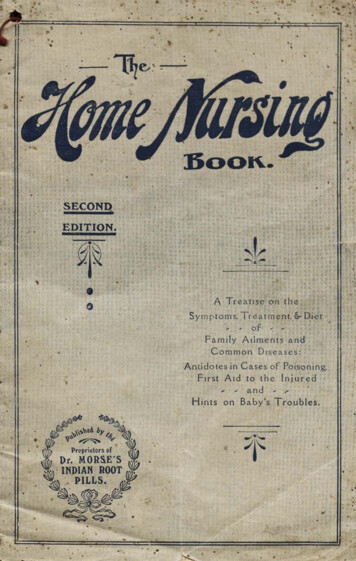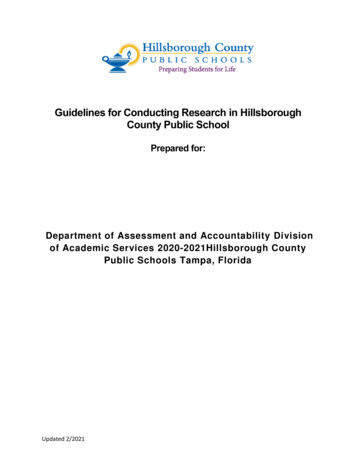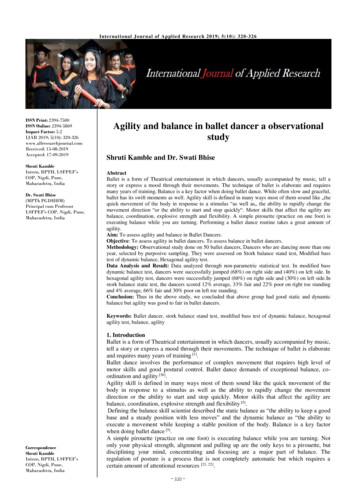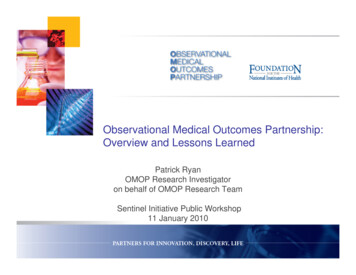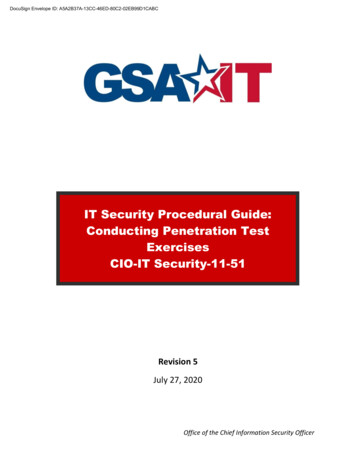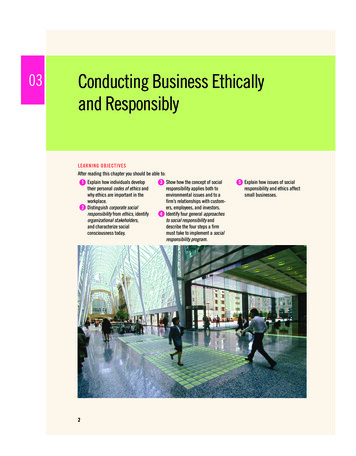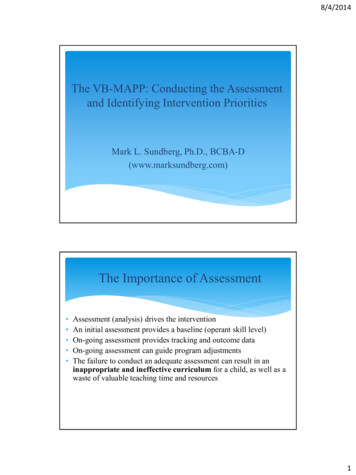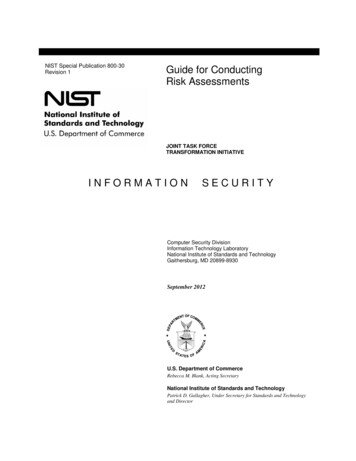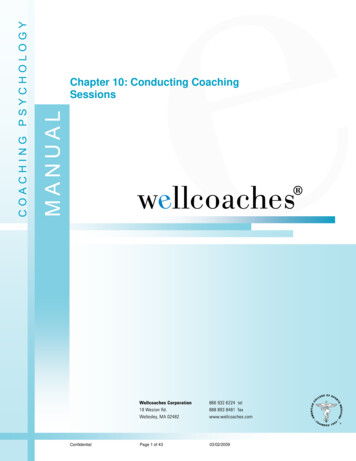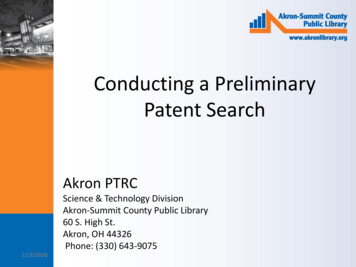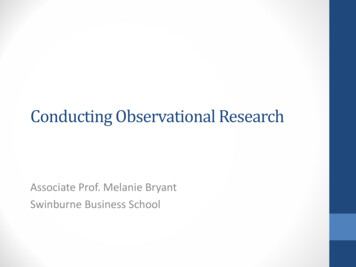
Transcription
Conducting Observational ResearchAssociate Prof. Melanie BryantSwinburne Business School
Overview of the workshop The what's, aims and benefits of observation Methodological considerations Observation as a method Ethical considerations Observation templates Developing field notes Analysing and writing about observational data Evaluating quality Plenty of time for discussion and questions
Where do observations fit into a broader researchdesign? Research question(s) Paradigmatic approach OntologyEpistemologyTheoretical perspectiveMethodology Information about the sample/participants Method(s) of data collection Method(s) of data analysis
What is going on here?
What is observation? Observation is a method of data collection in whichresearchers observe within a specific research field. It issometimes referred to as an unobtrusive method Participant observation involves the observer being a memberof the setting in which they are collecting data – there arequite a few variations of this definition Observation is normally associated with an ethnographicmethodology (more later) but can be used as part of otherresearch designs All of the above seek to find out “what is going on here?”
The value of observation The research is better able to understand and capture the contextwithin which people interact Firsthand experience with a setting allows researchers to open todiscovery and inductive, rather than guessing what the context islike The research may see things that routinely escape awareness of theparticipant using a different method It provides a chance to learn things that people may be unwilling todiscuss in an interview
Aims of observational research1. Seeing through the eyes of Viewing events, actions, norms, values etcfrom the perspective of the people beingstudied2. DescriptionAttending to mundane detail to help usunderstand what is going on and to provideclues to other layers of reality3. ContextualisationWhatever the sphere in which the data arebeing collected, we can only understandevents when they are situated in the widersocial and historical context4. ProcessViewing social life as a series of interlockingevents5. Flexible researchA preference for semi or unstructuredresearch design, rather than imposing priorframes of reference onto the study6. Avoiding early use of theories andconceptsRejects premature attempts to imposetheories and concepts which may exhibitpoor fit with participants’ perspectivesSource: Bryman (1988: 61-2); Silverman (2008)
Methodological principalsKey featuresJoneset al (2006)ObjectivismConstructionismSubjectivismLinked to positivist approachesLinked to interpretivism,constructivism, poststructuralism)Linked to critical theoryThe purpose of theresearchTo explain and predict –research should begeneralizable; there is anobjective truth independent ofthe researcherTo understand complexhuman phenomenaTo question acceptedknowledge and shed light onsocial injustice so that changecan occurRole of researcherTranslatorInterpreterEngaged advocateRelationship betweenresearcher and participantShould be objective: distanceand detachment fromparticipantNot possible to be objective,researcher is a co-constructorand shares relationship withparticipantObjectivity harmful –researcher’s position needs tobe made clear in terms ofhow it influences the researchand can lead to changeResearch “truths”Truth can be obtained throughrigorous researchTruth is co-constructed, ortruth may be considered tonot existConcept of truth unlikely toexist, meaning shifts overtime
Ethnography v observation Ethnography is a methodology developed for the study of cultures andcultural sense-making Derived from anthropology Is normally linked to inductive research – a focus on local interpretations Aimed at understanding an insider’s perspective: habits, norms,practices, rituals, patterns of interaction, rituals Can be designed from different epistemological approaches – e.g.,critical, interpretivist, postmodernist etc. Can include auto-ethnography or performance ethnography Ethnography involves observation, but not all observation has to beethnographic
An example of ethnography http://www.youtube.com/watch?v WtOuZMe FqU
Methodological principles Angrosino (2005) makes two important methodological distinctions: Objectivist approach to ethnography/observation Related to positivist research Researchers claim that they are able to maintain objectivity and that they do not influence,interfere with people or activities under observation They adhere to strict rules of rigour that prevent researchers’ biasing the data To not do so would involve “going native” – the data was be rendered suspect Postmodernist approach to ethnography/observation Related to approaches such as social constructionism etcResearchers influence and affect the research setting and are very much a part of thisAn “extra pair of hands”Observational objectivity is neither feasible nor desirable – the researcher is part of theproduction of knowledge Regardless, we should acknowledge the Hawthorne Effect created by researcherswhen conducting observation
An example of a research design using observationResearch questions1. How do members of operating teamsinteract and communicate?2. What contributes to the communicationclimates in different operating theatres?3. Do interprofessional values exist in theatreteams. If so, how do they impact on thebehaviour and interactions of operatingtheatre team members?Ontology: Social constructionistEpistemology: InterpretivistMethodology: EthnographyResearch site: operating theatres in general,vascular and orthopaedic surgery; compareone metropolitan and one regional hospitalsiteMethods of data collection:1. Observations (approximately 40 hours in theatre across the two sites);2. Field memo’s3. Informal conversations with staff in the theatre and/or theatre suite (e.g.Change rooms, staff room, corridors etc)4. Conduct semi-structured interviews to follow up and clarify findings fromobservations (include questions about medical jargon, differences inprocedure amongst team leaders etc)Participants: surgeons, registrars, nursing staff(scrub, scout and anaesthetic), teamleaders, theatre technicians, patientsData analysis: coding of observation notes; field notes (which includes detailsof informal conversations with staff; analytic memos; recording ofpersonal experiences, context); thematic analysisOther key personnel: Director of clinical services;director of medical services; theatremanager; patient admissions manager;admissions staff; team leaders of eachtheatreResearch team: Myself (organisational behaviourist); A (sociologist); S(sociologist); E (epidemiologist).
Key points to consider when using observation as amethod Is it compatible with your research aims, questions and paradigmaticapproach? How will it add value to your research in addition to or in place of othermethods? Are there any ethical, access or other issues that might makeobservations difficult? How will you collect observational data? Structured template,unstructured, semi-structured? How will you organise your field notes, personal notes etc? Will other data methods be used? If so, how will they add value? If youare seeking to triangulate, how will this be compatible withepistemology etc?
Ethical issues in ethnography/observation Ethical issues are not dissimilar from other forms of qualitativeresearch. Informed consent of all involved Guarantee of anonymity Giving back to the research site .but there are some additional issues we should be aware of We commit ourselves to long-term relationshipsTrust is a very important issueWe will see and hear things of a sensitive natureWe may become a “sounding board” for others Van Maanen (1988) describes us as “part spy, part voyeur, part fan, partmember”
Practice your own observation – Part 11.Unstructured observationFind a spot nearby where you can conduct a 10 minuteuninterrupted observation. As part of this activity, notedown what is happening in your location including: What is happening within the locationAmbience, atmosphere, environmentPhysical characteristics of the settingHow you are feeling and how you think this might influence whatyou are observing and recordingThe aim of the activity is to develop a set of notes thatdescribe the scene as much as possible.
What do we “look for” when doing observation? Observations have to be tied to the research question(s), which should act as aguide Observations can be unstructured, semi-structured or structured. Semistructured and structured involve the development of an observation template. Observations should normally have some structure but not to the point that weare “locked in” to a particular theoretical approach Unstructured observation can be a waste of time if we are time poor but wealso need to allow for other things to emerge from the data Piloting data collection is an important way of determining what is important toinclude or what could possibly be ignored Allow data to emerge through the process – field notes towards the end of datacollection might look very different from field notes at the start
What do we look for in observation? What is your role in the setting? Are you a background observer , an extrapair of hands, or a participant? Should you develop a set of notes away from the observation setting? Some things to consider - Context: What does the site look like? Smell like? Feel like? How is it set up physically?Take note of this for richness of data Draw the site or take a photo (ethics permitting) – this will jog your memorylater and can be used as part of the data Consider the following photo what do you “see” and how these photos makeyou feel? Do you have prior knowledge or experience? How does ourbackground influence the way we see this? (important for reflexivity if you areusing more interpretive approaches)
What do we look for in observation? Are there certain aspects of the site that you find physically distracting?If so, how do these effect your data collection? Are there aspects that you find psychological or physiologicallydistracting? How do these effect your data collection? What is happening when nothing seems to be happening? How do I collect data without affecting the research setting too much?Or does it matter? Am I learning from being involved in interactions inthe setting? In observations, our data comes predominantly from field notes
Field notes Silverman highlights a number of different questions we should considerwhen conducting observations and writing field notes1.2.3.4.5.What are people doing? What are they trying to accomplish?How exactly do they do this?How do people characterise and understand what is going on?What assumptions do they make?Analytic questions: What do I see going on here? What did I learnfrom these notes? Why did I include them? Other things to consider: What else is happening in this site that is relevant to my researchquestion(s)?How do I feel collecting this data? Comfortable, imposter etc – howwill this affect the data (reflexivity)?If you are not sure whether you should record it, record it anyway –it’s better to have too much than not enough.What do I do with my data now that it’s collected?
Practice your own observation – Part 22. Structured observationBased on the unstructured observation, develop a specificresearch question about the location. Now repeat theobservation for a 10 minute period but only noting data thatrefers specifically to your research question.As part of this exercise, consider the issues we havediscussed in terms of what to look for and how to write fieldnotes.
Now what do we do? Observational data should be analysed as appropriate to youroverall analytical strategy. Is your work inductive or deductive? What happens if more than one observer is on the research team?How should you treat the analysis of data? How does this fit withyour broader epistemological approach to the research?
Ensuring quality in observational research A common mistake often made in research is judging qualitativework using the criteria of quantitative research Terms such as reliability, validity, objectivity, measurability, representativeness &generalizability are based on quantitative or scientific work “The language of positivistic research is not congruent with or adequate for qualitativework” (Ely et al, 1991: 95; see also Creswell, 2007) Another common mistake is the assumption that quality criteriadoes not need to be used in qualitative research Qualitative researchers must ensure that their work is legitimate and rigorous There are many different approaches to qualitative research therefore a “one size fitsall” approach should not be taken when evaluating quality Qualitative studies often use terms such as authenticity, trustworthiness, reflexivity,particularity, subjectivity and many more! Your observational work should ‘follow the rules’ of your epistemological approach atall times
Patton’s (2002) Criteria for judging the quality of qualitative researchPositivismConstructivismCritical theoryObjectivity of the researcher(minimize bias)Subjectivity acknowledged (takesinto account biases)Critical perspective – increasesawareness about injusticesValidity of the dataTrustworthinessIdentifies nature and sources ofinequalities and injusticesSystematic rigour of fieldworkproceduresAuthenticityRepresents the perspectives of theless powerfulTriangulation across data sources,methods, analystsTriangulation across data sourcesor theoretical perspectives(problematizing)Makes visible the ways in whichthose with more power exerciseand benefit from powerReliability of codings and patternsanalysesReflexivityEngages those with less powerrespectfully and collaborativelyCorrespondence of findings torealityMaintaining integrity of uniqueca
structured and structured involve the development of an observation template. Observations should normally have some structure but not to the point that we are “locked in” to a particular theoretical approach Unstructured observation can be a waste of time if we are time poor but we also need to allow for other things to emerge from the data Piloting data collection is an .
